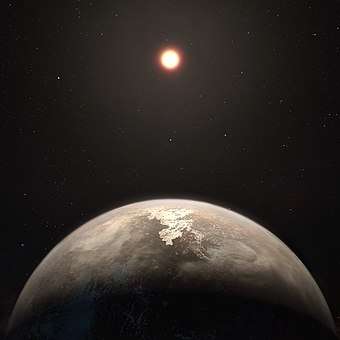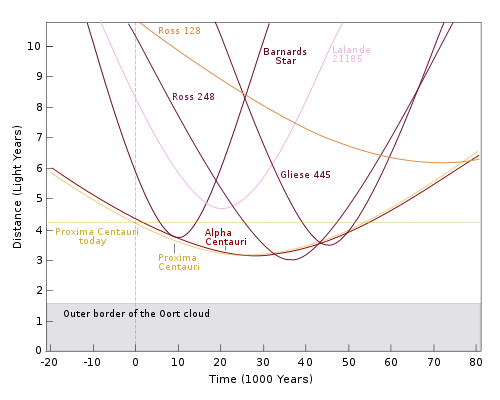Ross 128
Ross 128 is a red dwarf in the equatorial zodiac constellation of Virgo, near β Virginis. The apparent magnitude of Ross 128 is 11.13,[3] which is too faint to be seen with the unaided eye. Based upon parallax measurements, the distance of this star from Earth is 11.007 light-years (3.375 parsecs), making it the twelfth closest stellar system to the Solar System. It was first cataloged in 1926 by American astronomer Frank Elmore Ross.[14]
 Artist's impression of the planet Ross 128 b, with the star Ross 128 visible in the background[1] Credit: European Southern Observatory | |
| Observation data Epoch J2000 Equinox J2000 | |
|---|---|
| Constellation | Virgo |
| Right ascension | 11h 47m 44.3969s[2] |
| Declination | +00° 48′ 16.4049″[2] |
| Apparent magnitude (V) | 11.13[3] |
| Characteristics | |
| Spectral type | M4 V[4] |
| U−B color index | +2.685[5] |
| B−V color index | +1.59[6] |
| Variable type | Flare star[7] |
| Astrometry | |
| Radial velocity (Rv) | −31.0[8][9] km/s |
| Proper motion (μ) | RA: 607.678±0.137[2] mas/yr Dec.: −1223.323±0.078[2] mas/yr |
| Parallax (π) | 296.3073 ± 0.0699[2] mas |
| Distance | 11.007 ± 0.003 ly (3.3749 ± 0.0008 pc) |
| Absolute magnitude (MV) | 13.53[3] |
| Details | |
| Mass | 0.168±0.017[10] M☉ |
| Radius | 0.1967±0.0077[10] R☉ |
| Luminosity (bolometric) | 0.00362 ± 0.00039[11] L☉ |
| Surface gravity (log g) | 3.40[12] cgs |
| Temperature | 3192±60[10] K |
| Metallicity [Fe/H] | −0.02±0.08[13] dex |
| Age | 9.45±0.60[13] Gyr |
| Other designations | |
FI Virginis, FI Vir, G 010-050, GCTP 2730, GJ 447, HIP 57548, LHS 315, Vyssotsky 286, LTT 13240, LFT 852, LSPM PM I11477+0048.[10] | |
| Database references | |
| SIMBAD | data |
Properties

This low mass star has a stellar classification of M4 V,[4] which places it among the category of stars known as red dwarfs. It has 15%[12] of the mass of the Sun and 21%[15] of the Sun's radius, but generates energy so slowly that it has only 0.033% of the Sun's visible luminosity;[3] however, most of the energy being radiated by the star is in the infrared band, with the bolometric luminosity being equal to 0.36% of solar.[16] This energy is being radiated from the star's outer atmosphere at an effective temperature of 3,180 K.[4] This gives it the cool orange-red glow of an M-type star.
Ross 128 is an old disk star, which means it has a low abundance of elements other than hydrogen and helium, what astronomers term the star's metallicity, and it orbits near the plane of the Milky Way galaxy.[17] The star lacks a strong excess of infrared radiation. An infrared excess is usually an indicator of a dust ring in orbit around the star.[18][19]
In 1972, a flare was detected from Ross 128. It was observed to increase in brightness by about half a magnitude in the ultraviolet U band, returning to normal brightness in less than an hour. At optical wavelengths, the brightness changes were almost undetectable.[20] It was classified as a flare star and given the variable star designation FI Virginis.[21] Because of the low rate of flare activity, it is thought to be a magnetically evolved star. That is, there is some evidence that the magnetic braking of the star's stellar wind has lowered the frequency of flares, but not the net yield.[22]
Brightness variations thought to be due to rotation of the star and magnetic cycles similar to the sunspot cycle have also been detected. These cause changes of just a few thousandths of a magnitude. The rotation period is found to be 165.1 days, and the magnetic cycle length 4.1 years.[23]
Ross 128 is orbiting through the galaxy with an eccentricity of 0.122, causing its distance from the Galactic Center to range between 26.8–34.2 kly (8.2–10.5 kpc).[24] This orbit will bring the star closer to the Solar System in the future. The nearest approach will occur in approximately 71,000 years, when it will come within 6.233 ± 0.085 ly (1.911 ± 0.026 pc).[9]
Planetary system
Ross 128 b was discovered in July 2017 by the HARPS instrument at the La Silla Observatory in Chile, by measuring changes in radial velocity of the host star. Its existence was confirmed on 15 November 2017. It is the second-closest known Earth-size exoplanet, after Proxima b.[25] It is calculated that Ross 128 b has a minimum mass of 1.35 times the Earth, and orbits 20 times closer to its star than Earth orbits the Sun, intercepting only about 1.38 times more solar radiation than Earth,[11][26] increasing the chance of retaining an atmosphere over a geological timescale. Ross 128 b is a closely orbiting planet, with a year (rotation period) lasting about 9.9 days.[27][28] At that close distance from its host star, the planet is most likely tidally locked, meaning that one side of the planet would have eternal daylight and the other would be in darkness.[29][30] Near-infrared high-resolution spectra from APOGEE have demonstrated that Ross 128 has near solar metallicity; Ross 128 b therefore most likely contains rock and iron. Furthermore, recent models generated with these data support the conclusion that Ross 128 b is a "temperate exoplanet in the inner edge of the habitable zone." [31]
| Companion (in order from star) |
Mass | Semimajor axis (AU) |
Orbital period (days) |
Eccentricity | Inclination | Radius |
|---|---|---|---|---|---|---|
| b | ≥ 1.35±0.2 M⊕ | 0.0493±0.0017 | 9.8596±0.0056 | 0.036±0.092 | — | — |
Radio signals
In the spring of 2017 Arecibo astronomers detected strange radio signals thought to originate from Ross 128 that were unlike any they had seen before.[32] SETI's Allen Telescope Array was used for follow-up observations and was unable to detect the signal but did detect man made interference, making it seem clear that the Arecibo detections were due to transmissions from Earth satellites in geosynchronous orbit. Ross 128 has a declination (a coordinate which can be likened to latitude) of close to 0 degrees, which places it in the thick of a phalanx of these satellites. It was telemetry from these satellites, and not extraterrestrials, that accounts for the signals.[33]
See also
- List of nearest stars
- PSR B1919+21 - pulsar mistaken for an alien radio signal (LGM-1)
- Ross 128 in fiction
References
- "Closest Temperate World Orbiting Quiet Star Discovered - ESO's HARPS instrument finds Earth-mass exoplanet around Ross 128". www.eso.org. Retrieved 15 November 2017.
- Brown, A. G. A.; et al. (Gaia collaboration) (August 2018). "Gaia Data Release 2: Summary of the contents and survey properties". Astronomy & Astrophysics. 616. A1. arXiv:1804.09365. Bibcode:2018A&A...616A...1G. doi:10.1051/0004-6361/201833051. Gaia DR2 record for this source at VizieR.
- The One Hundred Nearest Star Systems, Research Consortium on Nearby Stars, 2012-01-01, retrieved 2017-11-15
- Gautier, Thomas N., III; et al. (2004), "Far Infrared Properties of M Dwarfs", Bulletin of the American Astronomical Society, 36: 1431, Bibcode:2004AAS...205.5503G
- Rufener, F. (October 1976), "Second catalogue of stars measured in the Geneva Observatory photometric system", Astronomy & Astrophysics Supplement Series, 26: 275–351, Bibcode:1976A&AS...26..275R
- Warren, W. H., Jr. (1978), "Photoelectric Photometric Catalogue of Homogeneous Means in the UBV System", Observatory, Geneva
- Samus, N. N.; Durlevich, O. V.; et al. (2009). "VizieR Online Data Catalog: General Catalogue of Variable Stars (Samus+ 2007-2013)". VizieR On-line Data Catalog: B/gcvs. Originally Published in: 2009yCat....102025S. 1. Bibcode:2009yCat....102025S.
- Gontcharov, G. A. (2006), Pulkovo Compilation of Radial Velocities for 35493 Hipparcos Stars, retrieved 2010-04-18
- García-Sánchez, J.; et al. (2001), "Stellar encounters with the solar system" (PDF), Astronomy and Astrophysics, 379 (2): 634–659, Bibcode:2001A&A...379..634G, doi:10.1051/0004-6361:20011330
- Mann, Andrew W.; Feiden, Gregory A.; Gaidos, Eric; Boyajian, Tabetha; Braun, Kaspar von (4 May 2015). "HOW TO CONSTRAIN YOUR M DWARF: MEASURING EFFECTIVE TEMPERATURE, BOLOMETRIC LUMINOSITY, MASS, AND RADIUS" (PDF). The Astrophysical Journal. 804 (1): 64. arXiv:1501.01635. Bibcode:2015ApJ...804...64M. doi:10.1088/0004-637X/804/1/64. Retrieved 15 November 2017.
- Bonfils, Xavier (2017). "A temperate exo-Earth around a quiet M dwarf at 3.4 parsecs". Astronomy and Astrophysics. arXiv:1711.06177. Bibcode:2018A&A...613A..25B. doi:10.1051/0004-6361/201731973.
- Rodonò, Marcello, "The Atmospheres of M Dwarfs: Observations", The M-Type Stars, Washington: NASA, pp. 409–453
- Mann, Andrew W.; et al. (May 2015). "How to Constrain Your M Dwarf: Measuring Effective Temperature, Bolometric Luminosity, Mass, and Radius". The Astrophysical Journal. 804 (1): 38. arXiv:1501.01635. Bibcode:2015ApJ...804...64M. doi:10.1088/0004-637X/804/1/64. Vizier catalogue entry
- Ross, Frank E. (1926), "New proper-motion stars, (second list)", Astronomical Journal, 36 (856): 124–128, Bibcode:1926AJ.....36..124R, doi:10.1086/104699
- White, Stephen M.; Jackson, Peter D.; Kundu, Mukul R. (December 1989), "A VLA survey of nearby flare stars", Astrophysical Journal Supplement Series, 71: 895–904, Bibcode:1989ApJS...71..895W, doi:10.1086/191401
- "HIP 57548", NASA Exoplanet Archive, retrieved 2018-11-30
- Sánchez, F. (1990), Vazquez, M. (ed.), New windows to the universe, 2, Cambridge University Press, p. 313, ISBN 0-521-38429-X
- Jura, M.; et al. (September 2004), "Mid-Infrared Spectra of Dust Debris around Main-Sequence Stars", The Astrophysical Journal Supplement Series, 154 (1): 453–457, arXiv:astro-ph/0405632, Bibcode:2004ApJS..154..453J, doi:10.1086/422975
- Gautier, Thomas N., III; et al. (September 2007), "Far-Infrared Properties of M Dwarfs", The Astrophysical Journal, 667 (1): 527–536, arXiv:0707.0464, Bibcode:2007ApJ...667..527G, doi:10.1086/520667
- Lee, T. A; Hoxie, D. T (1972). "The Observation of a Stellar Flare in the dM5 Star Ross 128". Information Bulletin on Variable Stars. 707: 1. Bibcode:1972IBVS..707....1L.
- Kukarkin, B. V; Kholopov, P. N; Kukarkina, N. P; Perova, N. B (1975). "60th Name-List of Variable Stars". Information Bulletin on Variable Stars. 961: 1. Bibcode:1975IBVS..961....1K.
- Skumanich, Andrew (1986-10-15), "Some evidence on the evolution of the flare mechanism in dwarf stars", Astrophysical Journal, Part 1, 309: 858–863, Bibcode:1986ApJ...309..858S, doi:10.1086/164654
- Stelzer, B; Damasso, M; Scholz, A; Matt, S. P (2016). "A path towards understanding the rotation-activity relation of M dwarfs with K2 mission, X-ray and UV data". Monthly Notices of the Royal Astronomical Society. 463 (2): 1844. arXiv:1607.03049. Bibcode:2016MNRAS.463.1844S. doi:10.1093/mnras/stw1936.
- Allen, C.; Herrera, M. A. (1998), "The galactic orbits of nearby UV Ceti stars", Revista Mexicana de Astronomía y Astrofísica, 34: 37–46, Bibcode:1998RMxAA..34...37A
- Koren, Marina. "An Earth-Sized Exoplanet in Our Cosmic Neighborhood". The Atlantic. The Atlantic Monthly Group. Retrieved 15 November 2017.
- Nearby planet is 'excellent' target in search for life. Paul Rincon, BBC News. 15 November 2017.
- Bonfils, Xavier (2017). "A temperate exo-Earth around a quiet M dwarf at 3.4 parsecs". Astronomy and Astrophysics. arXiv:1711.06177. Bibcode:2018A&A...613A..25B. doi:10.1051/0004-6361/201731973.
- A potentially habitable planet has been discovered just 11 light-years away. John Wenz, Astronomy Magazine. 15 November 2017.
- Nearby Earth-sized Alien World Orbits 'Quiet' Star, Boosting Habitable Potential. Ian O'Neill, How Stuff Works. 15 November 2017. Quote: "Tidal lock[ing] is expected for Ross 128 b," says Nicola Astudillo-Defru, who works at the Geneva Observatory, University of Geneva in Switzerland, and is co-author of the study.
- Ross 128. Sol Station. November 2017.
- Souto, Diogo; Unterborn, Cayman T.; Smith, Verne V.; Cunha, Katia; Teske, Johanna; Covey, Kevin; Bárbara Rojas-Ayala; García-Hernández, D. A.; Stassun, Keivan (2018). "Stellar and Planetary Characterization of the Ross 128 Exoplanetary System from APOGEE Spectra". The Astrophysical Journal Letters. 860 (1): L15. arXiv:1805.11633. Bibcode:2018ApJ...860L..15S. doi:10.3847/2041-8213/aac896. ISSN 2041-8205.
- "The Strange Radio Signals Coming From a Nearby Star". 17 July 2017.
- Shostak, Seth. "Signals from A Nearby Star System?". seti.org. Retrieved 17 September 2017.
External links
| Wikimedia Commons has media related to Ross 128. |